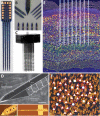Advanced neurotechnologies for chronic neural interfaces: new horizons and clinical opportunities
- PMID: 19005048
- PMCID: PMC3844837
- DOI: 10.1523/JNEUROSCI.3879-08.2008
Advanced neurotechnologies for chronic neural interfaces: new horizons and clinical opportunities
Figures



References
-
- Andersen RA, Burdick JW, Musallam S, Pesaran B, Cham JG. Cognitive neural prosthetics. Trends Cogn Sci. 2004;8:486–493. - PubMed
-
- Aoki F, Fetz EE, Shupe L, Lettich E, Ojemann GA. Increased gamma-range activity in human sensorimotor cortex during performance of visuomotor tasks. Clin Neurophysiol. 1999;110:524–537. - PubMed
-
- Barthó P, Hirase H, Monconduit L, Zugaro M, Harris KD, Buzsáki G. Characterization of neocortical principal cells and interneurons by network interactions and extracellular features. J Neurophysiol. 2004;92:600–608. - PubMed
Publication types
MeSH terms
Grants and funding
- R44 NS060269/NS/NINDS NIH HHS/United States
- P41 EB002030/EB/NIBIB NIH HHS/United States
- EB006356/EB/NIBIB NIH HHS/United States
- R43 NS060269/NS/NINDS NIH HHS/United States
- R01 NS044287/NS/NINDS NIH HHS/United States
- R37 NS012542/NS/NINDS NIH HHS/United States
- EB 002030/EB/NIBIB NIH HHS/United States
- R01 EB000856/EB/NIBIB NIH HHS/United States
- R43 NS054346/NS/NINDS NIH HHS/United States
- RR00166/RR/NCRR NIH HHS/United States
- NS054346/NS/NINDS NIH HHS/United States
- R44 NS054346/NS/NINDS NIH HHS/United States
- NS12542/NS/NINDS NIH HHS/United States
- R01 EB006356/EB/NIBIB NIH HHS/United States
- P51 RR000166/RR/NCRR NIH HHS/United States
- NS060269/NS/NINDS NIH HHS/United States
- R01 NS012542/NS/NINDS NIH HHS/United States
- EB000856/EB/NIBIB NIH HHS/United States
- NS044287/NS/NINDS NIH HHS/United States
LinkOut - more resources
Full Text Sources
Other Literature Sources
